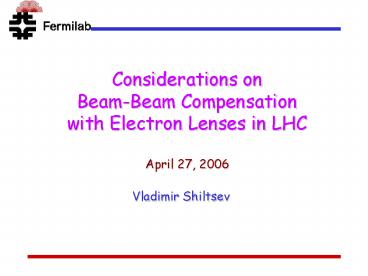Vladimir Shiltsev - PowerPoint PPT Presentation
Title:
Vladimir Shiltsev
Description:
to compensate (in average) space charge forces of positevely ... or donut shape? 4/27/06, eBBC in LHC - Shiltsev. 7. e-Shape control. Gaussian. Optimized ... – PowerPoint PPT presentation
Number of Views:40
Avg rating:3.0/5.0
Title: Vladimir Shiltsev
1
Considerations on Beam-Beam Compensation with
Electron Lenses in LHCApril 27, 2006
- Vladimir Shiltsev
2
Content
- The idea, how it works, Tev experience
- eBBC in LHC and RHIC
- Possible plan to proceed
3
Original Idea Was (1997)
to compensate (in average) space charge forces
of positevely charged protons acting on
antiprotons in the Tevatron by interaction with
a negative charge of a low energy high-current
electron beam
4
Head-on and Long-Range BBCompensation
Yu.Alexahin
- Tev Run II 36x36 bunches in 3 trains
- compensate beam-beam tune shifts
- a) Run II Goal
- b) one TEL
- c) two TELs
- d) 2 nonlinear TELs
- requires
- 1-3A electron current
- stability dJ/Jlt0.1
- e-pbar centering
- e-beam shaping
5
E-lenses in RHIC and LHC
- In Tevatron TELs to compensate bunch-by-bunch
tune shift due to parasitic beam-beam
interactions ? - Requires pulsed e-beam (400-800ns)expensive HV
modulator - Need 2 lenses one vert and one horizontal at
unequal and large betas - Better have much wider e-beam than p-beam
uniform j(r) - Needed dQ0.006 max tuneshift dQ0.009 achieved
- LHC (and RHIC) can benefit from head-on beam-beam
compensation ? - Electrons compensate prtons thats good!
- DC beam no HV pulsers! (even better)
- Need 2 lenses one per beam at equal betas
- Large beta is OK (at least better than in
Tevatron as sigma_z/beta is not as big as in Tev
where it is 2) - E-beam j(r) should be Gaussian to match protons
at IPs easy! - Need dQ_max0.01 which is achievable ? see next
slide
6
basics of head-on beam-beam compensation
- If beam sizes and shapes are matched (ep)
- for LHC N_p1.1e11, N_ip4, for 10kV electrons
(beta0.2) one needs N_e4.4e11 or J_e1.2 A in
L3 m long e-beam
- approx Gaussian e-current distribution with rms
0.15-0.2 mm - or donut shape?
7
e-Shape control
Optimized (6-Gauss)
Gaussian
Just an example (see footprint on previous slide)
8
Challenges of Head-On Compensation
- Total current is not a challenge
- Optimum beam profile (vs bunchlength/beta, Qx,y)
-? - Compression to 0.15-0.2 mm is doable, though not
easy - Keeping beam straight within 0.02-0.03 mm
- Beam-beam centering within 0.02-0.03 mm
- Will bending sections do harm?
9
eLens configurations
10
TEL-2 B-field line straightness
S.Kamerdzhiev X.L.Zhang V.Shiltsev
11
Proposed Action Path
- Form an LHC eCompensation Task Force with a
charge to perform feasibility study in 1 year - Goal is to explore parameter space and
effectiveness of head-on BBC in LHC and RHIC - Cost 1.5FTE (200k) in SWF 50 for LARP
- In case of positive outcome, next steps may
include - Design of the TEL for RHIC 2007
200k SWF - Construction of TEL for RHIC
2008-2009 1300k MS - Demonstrate head-on compensation
2009-2010 200k SWF - Build TELs for LHC 2011-2012 1100k MS
- Install TELs in LHC and commission
2012-2014 200k SWF - Total 3,000k
12
Step 1 Theory and Simulations
- Will Gaussian or truncated Gaussian e-current
density distribution work (improve lifetime and
reduce diffusion rates)? - Straightforward tracking with a weak-strong code
- Is partial distribution helpful?
- Is there a better distribution?
- from first principles, theory, analytical
consideration - Effects are beta_TEL/beta/sigma_z or dP/P
- check in numerical tracking
- Importance of e-pbar(p) interaction in bending
sections - Which of three configurations is better?
- Is the choice tune dependent?
- Lifetime deterioration due to e-p misalignment
- e-beam straightness tolerances
- relative e-p displacement, angle
- Effect of low-frequency variations dJ, dX on beam
lifetime - Ion cleaning efficiency tolerances
- Cross-interaction with wires in LHC if there is
any - e-beam effect on coherent stability or
strong-strong beam-beam effects
13
slides
- backup
14
Proposed Action Plan
- Calibrate TEL-2 BPMs with stretch wire (Vic,
Seva, Brian) - Measure SEFT profile (Seva)
- Assemble TEL-2 vacuum system and bake (Gennady
John F) - Perform EoS and SoS studies with TEL-1 (ZXL, VS,
Seva) - Get the current, study transmission vs
B_gun/B_main (Seva, XL) - Study e-beam orbit vs current (same)
- Tracking studies with LIFETRAC (Sasha Valishev)
- Calibrate TEL-2 BPMs with short e-pulses (Vic and
Seva) - Measure TEL-2 e-beam profile (Seva, Vic)
- Commission MARX generator pulser (Howie we)
- Move install TEL-2 FY06 during shtdn (Gennady,
MSupp, et al) - Commission TEL-2 with 980 GeV p-beam, studies
with 2 TELs (all) - Build parts for TEL-1 modification (Gennady,
Seva, VS) - Modify TEL-1 in FY07 shutdown (as in FY06)
15
E-lenses in RHIC and LHC General Considerations
a1.7mm L2m E980GeV beta_e0.2
Scaling need a_e a_p and about same dQ0.01
Two factors
For RHIC beta_x 20 m for Tev beta_x100
gamma250 gamma1000 Thus
(B_c/B_main)4/5 x (B/B)_Tevatron ? easy!
For LHC beta_x 200 m for Tev beta_x100
gamma7000 gamma1000 Thus
(B_c/B_main)1/3.5 x (B/B)_Tevatron ? not easy,
but doable
16
Tevatron Electron Lens 1 (TEL-1)
90 deg bend
HV Modulator, HVHC PSs, Cryo, QPs, Vacuum,
Controls, Diagnostics, Cables
17
Tevatron Electron Lens 1 in the Tevatron Tunnel,
sector F48
18
Tuneshift dQhor0.009 by TEL
- Three p-bunches in the Tevatron, the TEL acts on
one of them
19
Beam-Beam at Low-beta Now Confined
5th order resonances Q3/50.600 EMITTANCE
BLOWUP
pbar
12th order resonances Q7/120.583 - Bad
lifetime
p
7th order resonances Q4/70.571 - HIGH LOSSES































